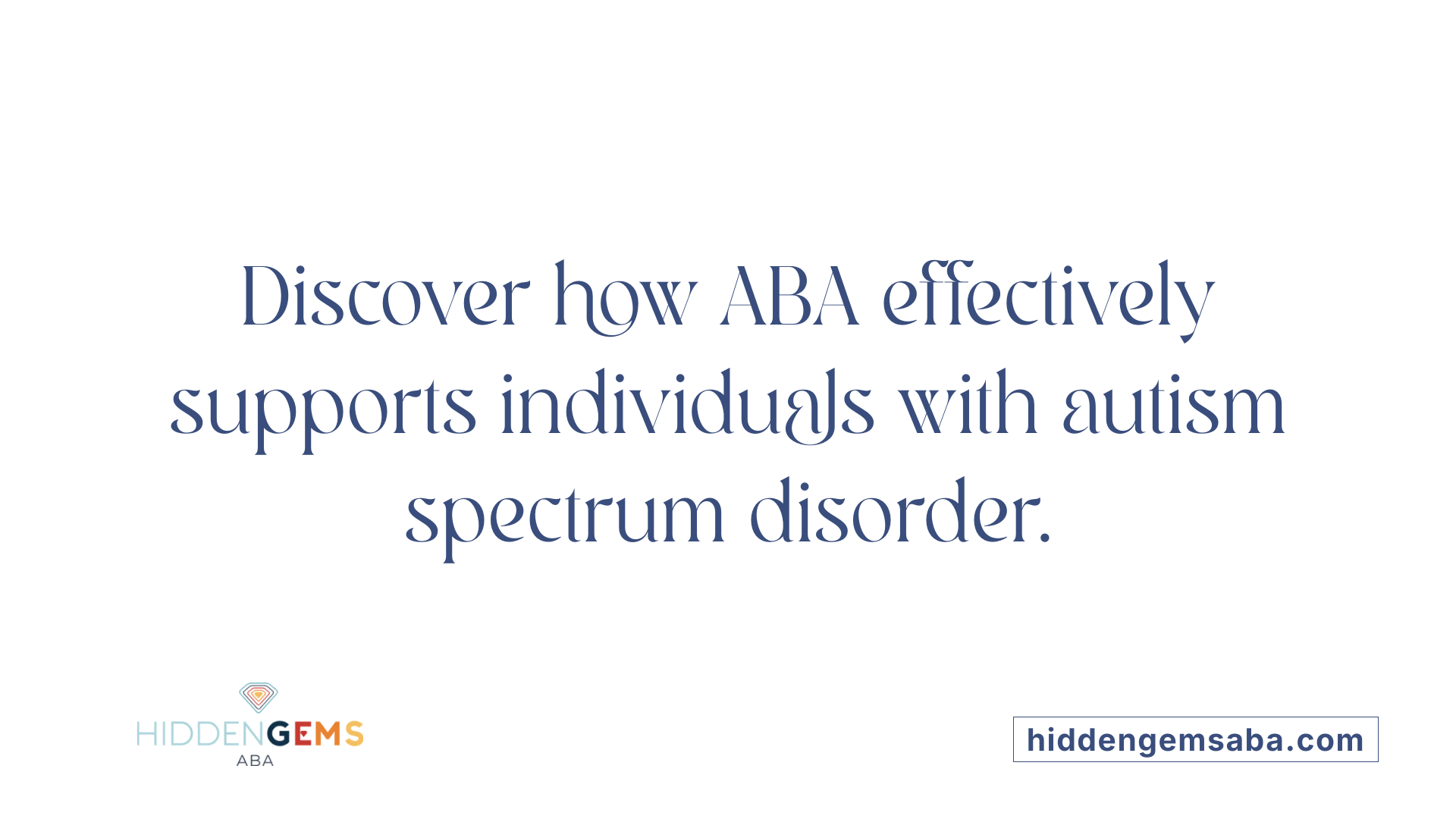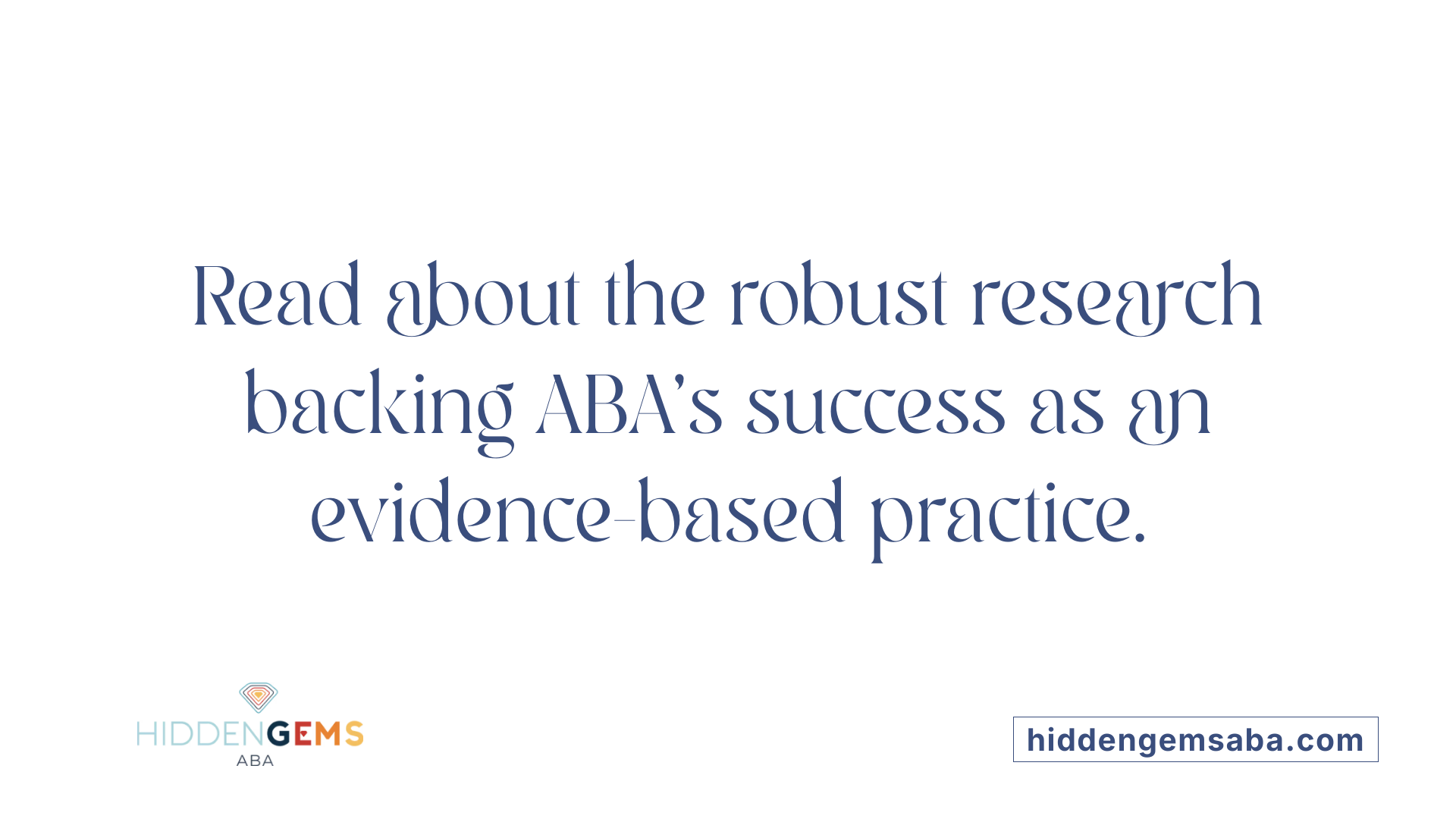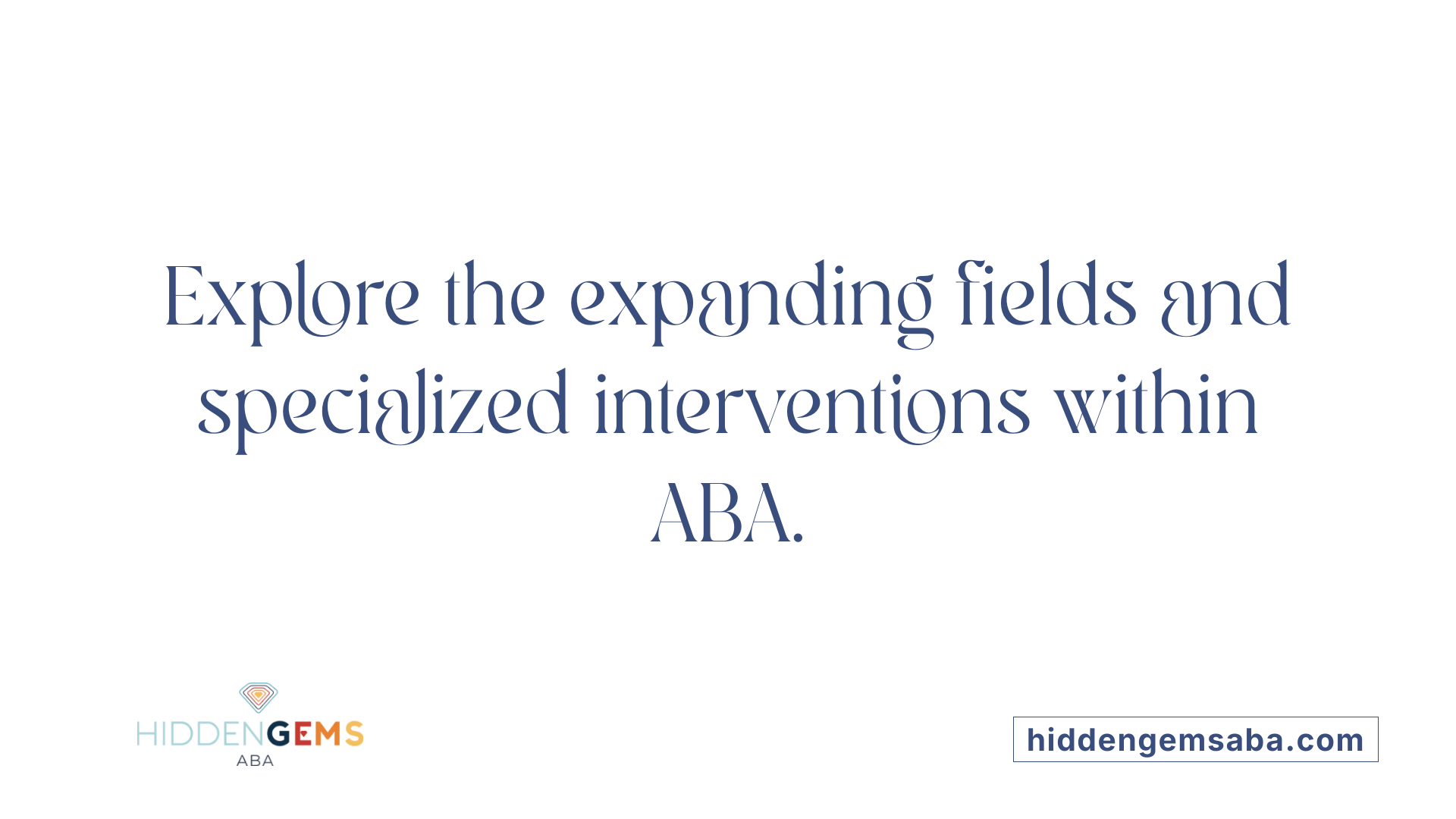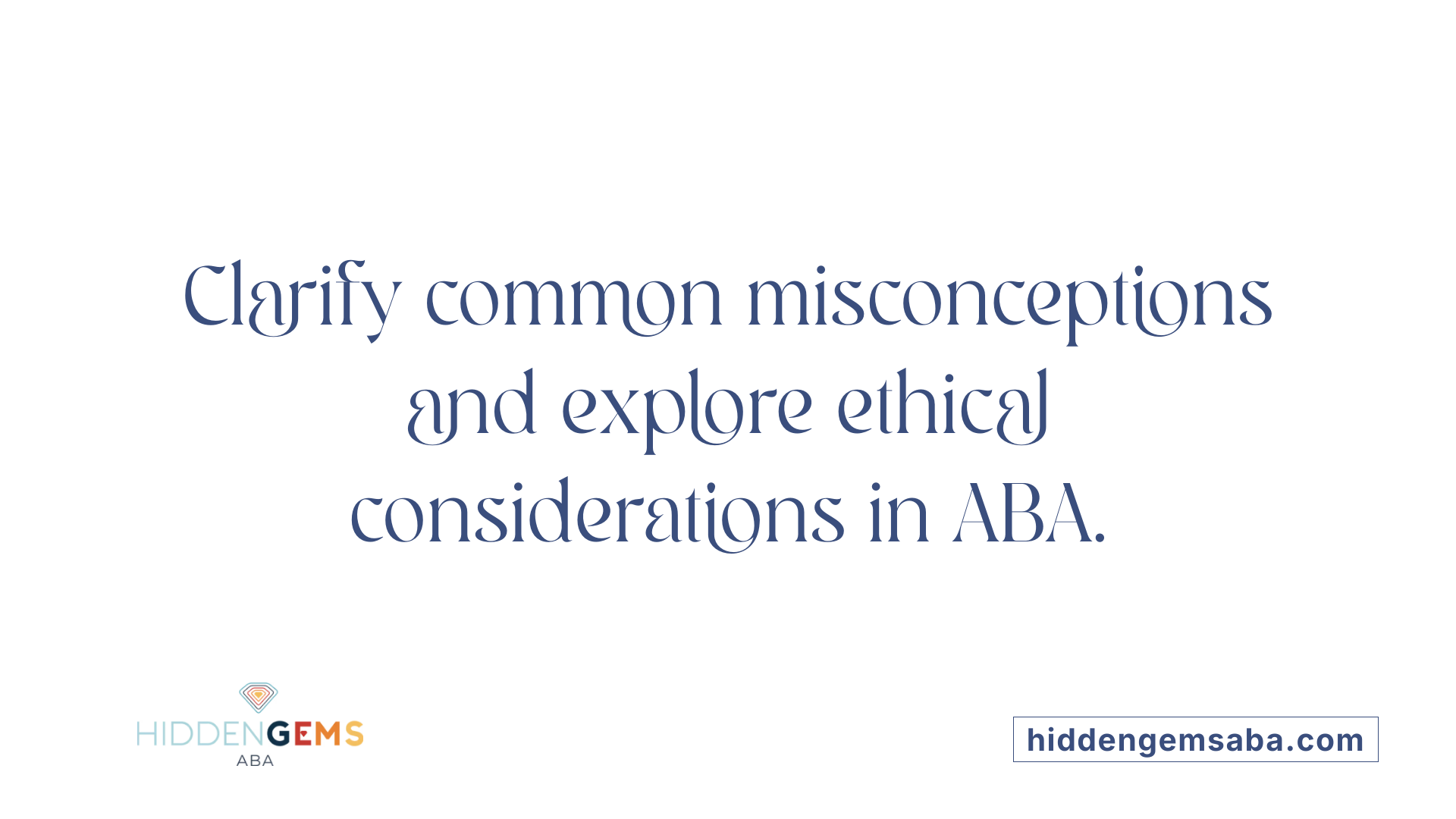Exploring the Foundations and Applications of ABA in Modern Behavior Science
Applied Behavior Analysis (ABA) stands as a cornerstone of behavioral science, merging rigorous scientific principles with practical interventions to modify behavior. Originally developed in the 1960s, ABA has evolved into a highly structured yet adaptable methodology that is particularly impactful in treating autism spectrum disorder (ASD) and other developmental conditions. This article delves into the core principles, scientific foundations, diverse applications, and future directions of ABA therapy and its vital role within the broader field of behavioral sciences.
What is ABA Therapy: Principles, Methodologies, and Goals
What is ABA therapy and what are its main principles and methodologies?
Applied Behavior Analysis (ABA) therapy is a scientific discipline dedicated to understanding and modifying behavior through systematic methods rooted in the principles of learning and environmental influence. It is widely used to support individuals with autism spectrum disorder (ASD) and other developmental disabilities, but its application extends beyond, helping people of all ages to develop new skills and reduce problematic behaviors.
At its core, ABA relies on several foundational techniques. One of the primary methods is reinforcement, which involves providing favorable outcomes—rewards—to increase desirable behaviors. Positive reinforcement, such as praise or tangible rewards, encourages the repetition of helpful actions like communication or self-care. Conversely, extinction is used to decrease behaviors that are harmful or interfere with learning by withholding reinforcement.
Additional methodologies include shaping, which systematically reinforces successive approximations toward a target behavior, prompting and fading to help individuals acquire new skills incrementally, and chaining, where complex skills are broken into smaller steps to teach sequences of behavior.
ABA's analytical framework centers around the ABCs—Antecedent, Behavior, and Consequence. This approach involves assessing what triggers a behavior (the antecedent), observing the behavior itself, and understanding what follows it (the consequence). By analyzing these elements, behavior analysts can identify functions of behaviors and develop effective intervention strategies.
The goal of ABA is both immediate and long-term. Treatment plans are highly individualized, designed to meet specific needs and developmental goals of each person. Behavior analysts conduct comprehensive assessments, including functional behavior assessments (FBAs), to identify the reasons behind behaviors and guide treatment planning.
Interventions are tailored, contextually appropriate, and flexible enough to adapt to ongoing progress and changing circumstances. Techniques are often incorporated into everyday routines and natural settings to promote generalization and maintenance of skills.
Professionals who deliver ABA, such as Board Certified Behavior Analysts (BCBAs) and trained therapists, perform ongoing data collection and analysis to monitor progress and modify interventions as needed. This continuous evaluation ensures that the therapy remains effective and aligned with individual goals.
Supported by decades of research, ABA is recognized by major health and psychological organizations as an evidence-based practice. Its focus on socially significant behaviors aims to promote meaningful improvements, enhancing communication, social interactions, independence, and quality of life.
In summary, ABA therapy combines scientific principles with practical strategies to bring about positive behavior change. Its methodologies—reinforcement, shaping, prompting, and functional analysis—are all designed to help individuals reach their fullest potential through structured, effective, and ethical intervention.
Foundations of ABA: Classical and Operant Conditioning
What scientific foundations underpin ABA, such as classical and operant conditioning?
Applied Behavior Analysis (ABA) is deeply rooted in the science of behavior, with its principles established through extensive research in behavioral psychology. The two main learning theories that underpin ABA are classical conditioning and operant conditioning.
Classical conditioning, originally discovered by Ivan Pavlov in the early 20th century, involves the process of learning through associations between stimuli. Pavlov’s experiments with dogs demonstrated that a neutral stimulus, when paired repeatedly with an unconditioned stimulus, could eventually elicit a conditioned response. For example, dogs began salivating not only when food was presented but also upon hearing a bell that had been associated with feeding. This form of learning is fundamental in understanding how certain behaviors become linked to environmental cues.
Operant conditioning, developed by B.F. Skinner, emphasizes the role of consequences in shaping behavior. This theory posits that behaviors are influenced by reinforcements that increase the likelihood of a behavior recurring and punishments that decrease it. Skinner’s experiments illustrated how positive reinforcement—such as rewards—encouraged behaviors, while negative consequences like punishment could reduce unwanted behaviors.
A critical model in ABA that integrates these concepts is the three-term contingency, which describes the interaction between antecedents (stimuli or events before behavior), behavior itself, and consequences (events following the behavior). This model helps explain how environmental factors and consequences influence future behavior and is essential for designing effective interventions.
These scientific principles are supported by a vast body of empirical research. Thousands of studies have demonstrated predictable ways in which behavior is learned and modified through environmental influences, reinforcing the validity of ABA’s approach.
In practice, ABA therapists use these foundational theories to analyze behaviors, identify environmental triggers, and implement tailored strategies like reinforcement and prompting. This systematic application ensures that behavior change is scientifically grounded, ethical, and effective.
Overall, the core scientific underpinnings of ABA—classical and operant conditioning and the three-term contingency—provide a rigorous framework for understanding and improving behavior. These principles form the backbone of interventions used to foster meaningful learning and development in individuals with autism and other developmental challenges.
ABA in Action: Treating Autism Spectrum Disorder (ASD)

How is ABA used in the treatment of autism spectrum disorder (ASD)?
Applied Behavior Analysis (ABA) is a structured, science-based therapy that is widely recognized as an effective intervention for children on the autism spectrum. It applies principles of learning theory, primarily operant conditioning, to promote positive behaviors and reduce undesirable ones.
In practice, ABA focuses on understanding the relationship between behavior and the environment, often through analyzing antecedents (what happens before a behavior), behaviors themselves, and consequences (what follows the behavior). This approach allows therapists to identify triggers for problematic behaviors and reinforce helpful skills.
Therapists use various techniques such as positive reinforcement—rewarding desirable behaviors to encourage their repetition—as well as prompting and fading to teach new skills like communication, social interaction, and self-care. Functional behavior assessments (FBAs) are conducted to tailor interventions specific to each individual's needs.
ABA programs are highly personalized, with professionals setting specific, measurable goals aligned with the child's developmental needs. These goals often include improving language and communication, developing social skills, increasing attention span and focus, and fostering independence in daily living activities.
Effective ABA strategies may be implemented in a variety of environments including the child's home, school, and community. This multisite approach helps ensure the generalization and maintenance of skills across different settings.
Research consistently supports ABA's effectiveness, especially when therapy begins early—ideally before age five. Early intensive ABA interventions have been linked with better developmental outcomes, including improved cognitive functioning, language skills, and social engagement.
The versatility of ABA also makes it suitable for use beyond childhood, helping adults adapt to new challenges associated with aging or other life changes.
Use of ABA in ASD treatment
| Aspect | Methods | Outcomes | Settings |
|---|---|---|---|
| Communication | Discrete Trial Training (DTT), Picture Exchange Communication System | Improved expressive and receptive language skills | Home, school, therapy clinics |
| Social Skills | Pivotal Response Treatment (PRT), naturalistic approaches | Better eye contact, sharing, social engagement | School, community |
| Adaptive Behaviors | Task analysis, chaining | Increased independence in daily activities | Home, community |
| Challenging Behaviors | Functional Behavior Assessments, extinction, redirection | Reduction in self-injury, tantrums | Clinical, home |
Tailoring interventions to individual needs
Each child's ABA program is customized after a thorough assessment. This involves analyzing the child's strengths, needs, and preferences to develop goals that are meaningful and achievable. Reinforcement strategies are selected based on what motivates the individual, and interventions are adjusted as progress occurs.
Family involvement is crucial in ensuring the success and generalization of skills. Caregivers are trained to implement strategies consistently across different environments.
Research evidence of effectiveness, including early intervention benefits
Hundreds of scientific studies support the benefits of ABA for children with ASD. Early intervention, particularly before age five, often results in more significant gains in language, cognitive skills, and daily functioning.
While some research notes limitations such as small sample sizes or methodological variability, overall findings indicate that ABA can greatly enhance independence and quality of life.
Smart program design and ongoing data collection are fundamental in measuring progress and refining treatment approaches.
Settings: home, school, community
ABA services are flexible and adaptable to various settings. In the home, parents play an active role in reinforcing skills and behaviors. Schools may implement ABA strategies within classroom routines to support social and academic development. Community settings such as parks or stores provide opportunities for real-world practice.
This multi-environment approach aims to ensure skills are maintained and generalized across different facets of life, promoting greater independence and integration.
Overall, ABA's structured yet flexible framework has made it a cornerstone in autism spectrum disorder treatment, emphasizing individualized care rooted in scientific evidence and ethical practice.
The Strength of Evidence: Research Supporting ABA’s Effectiveness

What research and evidence support the effectiveness of ABA?
Applied Behavior Analysis (ABA) is one of the most rigorously studied interventions for individuals with autism spectrum disorder (ASD). A wealth of scientific studies, including randomized controlled trials (RCTs), single-case experimental designs (SCEDs), and comprehensive meta-analyses, provides compelling evidence of its benefits.
RCTs are considered the gold standard in research. Several of these studies demonstrate that children who receive ABA therapy experience significant improvements in social skills, communication, and language development. For example, some trials report effect sizes indicating substantial gains, especially in early childhood. Meta-analyses aggregating multiple studies consistently find that ABA leads to meaningful behavior changes, reducing problematic behaviors and encouraging skill acquisition.
SCEDs, which involve detailed observation and repeated measurements of individuals, further support ABA’s effectiveness. These designs help show changes over time for specific learners, confirming that positive outcomes are directly related to ABA interventions. Large-scale controlled studies also highlight the durability of improvements, with many children maintaining gains in various domains long after intensive therapy concludes.
In practice, children undergoing ABA for approximately two years, with early intervention starting before age five, often show measurable progress. Notably, children with lower initial adaptive skills tend to benefit significantly, though improvements may vary. Some results indicate modest gains in daily living skills, such as self-care routines, highlighting that ABA is particularly effective in social and communication areas.
The collection of high-quality research solidifies ABA’s status as an evidence-based treatment. These findings are endorsed by leading health organizations, including the US Surgeon General and the American Psychological Association, emphasizing its scientific foundation and clinical utility.
In summary, robust research supports ABA’s role in enhancing social, communicative, and adaptive behaviors in individuals with ASD. Despite some limitations in measuring long-term quality of life outcomes, the overall evidence underscores its value as a cornerstone intervention in autism treatment.
| Research Design | Main Findings | Significance |
|---|---|---|
| Randomized Controlled Trials (RCTs) | Significant improvements in social and communication skills | Gold standard evidence, indicating strong efficacy |
| Meta-analyses | Aggregated positive effects across multiple studies | Confirms ABA’s overall effectiveness in diverse settings |
| Single-Case Designs (SCEDs) | Demonstrates consistent behavior change within individuals | Validates individual progress and intervention impact |
| Longitudinal Studies | Maintenance of skills over time | Supports durability of behavioral gains |
Understanding the rich body of research helps inform practices and policies, ensuring that ABA remains a scientifically supported approach to improving the lives of those with ASD.
Diversification of ABA: Subspecialty Areas and Interventions

What are the various subspecialty areas and types of ABA interventions?
Applied Behavior Analysis (ABA) is a flexible and expanding field that applies scientific principles to improve behavior across many settings and populations. Its diverse subspecialties reflect the broad application of its core techniques to meet the unique needs of different individuals and environments.
Among the main subspecialty areas are early intervention, educational ABA, organizational behavior management, clinical behavior analysis, behavioral pediatrics, and behavioral gerontology. These specialties serve specific populations, such as infants and toddlers, students in school settings, workers in organizational contexts, children with developmental disabilities, older adults, and even community health initiatives.
Other emerging areas include substance use disorder treatment, environmental sustainability efforts through behavior change, and sports psychology. Each focus area tailors ABA principles to address relevant behaviors, challenges, and goals.
In terms of intervention types, ABA utilizes several well-established methods. Discrete Trial Training (DTT) is a highly structured approach involving repeated trials with clear prompts and reinforcement. Natural Environment Teaching (NET) promotes learning in everyday contexts by leveraging natural interactions and play.
Pivotal Response Training (PRT) emphasizes targeting pivotal behaviors that influence multiple developmental areas, using child-led activities and reinforcement strategies. Verbal Behavior Interventions (VBI) focus specifically on language development, employing techniques rooted in Skinner’s analysis of language functions.
Comprehensive programs like Early Intensive Behavioral Intervention (EIBI) and the Denver Model integrate various ABA techniques within a naturalistic, developmental framework. These programs use prompting, modeling, shaping, task analysis, and functional assessments to create personalized intervention plans.
All therapeutic approaches use reinforcement strategies extensively, mainly positive reinforcement, to encourage desirable behaviors. Prompting, modeling, and fading are key tools to teach new skills, while functional behavior assessments help identify the functions of problematic behaviors.
The customization of ABA programs is essential. Each individual receives a tailored plan based on detailed assessments of their needs, strengths, and goals. This personalized approach ensures that interventions are effective, developmentally appropriate, and respectful of the individual’s preferences.
Overall, the versatility of ABA’s subspecialty areas and intervention techniques highlights its capacity to address a wide range of behavioral and developmental challenges effectively. This adaptability, grounded in scientific research, continues to expand as new applications and innovative strategies emerge.
Educational and Career Pathways in ABA and Behavioral Sciences

What educational and career opportunities are available in ABA and behavioral sciences?
Careers in ABA and behavioral sciences are broad and varied, offering options for individuals interested in making a meaningful impact through behavioral intervention and support. At the core, professionals such as behavior analysts, technicians, therapists, educators, and consultants work across different settings—including clinics, schools, private practices, hospitals, and community organizations.
To enter these fields, aspiring professionals typically pursue specialized education. Most roles require at least a bachelor’s degree, with many positions—particularly those involving direct intervention or clinical supervision—demanding a master's degree or higher in behavioral science, psychology, education, or related fields. Programs accredited or recognized by the Behavior Analyst Certification Board (BACB) provide foundational training necessary for certification such as the Board Certified Behavior Analyst (BCBA) or the Board Certified Assistant Behavior Analyst (BCaBA).
Popular educational pathways include online and hybrid programs offered by universities like Pepperdine University, Purdue Global, Walden University, and others. These programs teach core ABA principles, including applied techniques like positive reinforcement, functional behavior assessments, discrete trial training, and naturalistic interventions.
Once qualified, professionals can pursue a variety of roles:
- Behavior Analysts: Develop and oversee individualized treatment plans; conduct assessments; supervise therapists.
- Behavioral Technicians and Therapists: Implement intervention programs under supervision; support skill development and behavior reduction.
- Clinical Directors and Program Managers: Lead therapy teams and manage service quality.
- Special Education Teachers and School Counselors: Incorporate ABA principles to support students with autism and developmental disabilities.
- Consultants and Coaches: Provide training to families, schools, and organizations; promote best practices.
- Other Roles: Wellness coaches, clinical research staff, organizational consultants, animal trainers, and professionals in fields like sports performance, addiction counseling, weight management, and more.
The demand for qualified ABA professionals continues to grow rapidly. This expansion is driven by increasing awareness of ABA’s effectiveness, especially for autism, and broader application to other developmental, behavioral, and organizational issues.
Career advancement often involves gaining experience, earning certifications, and pursuing graduate studies. With experience, professionals may move into supervisory positions, clinical director roles, or specialization fields such as treatment of older adults, organizational behavior management, or research.
Job outlook and salary prospects are encouraging. According to the U.S. Bureau of Labor Statistics, employment of behavior analysts is projected to grow faster than average in the coming years. Salaries vary based on location, education, experience, and specific roles, but many ABA professionals enjoy competitive compensation.
Overall, a career in ABA and behavioral sciences offers the opportunity to effect positive change, work in diverse environments, and grow professionally while addressing important social and health issues.
ABA and Psychology: Differences, Intersections, and Broader Implications
How does ABA differ from psychology, and what is its relationship to the broader field?
Applied Behavior Analysis (ABA) is a scientific discipline that is a branch within behavioral science focusing specifically on understanding and modifying observable behaviors. Its primary methods involve techniques such as positive reinforcement, shaping, prompting, and functional behavior assessments. ABA concentrates on analyzing how environmental factors influence behavior and employs data-driven, structured interventions to improve social skills, communication, and daily living abilities, especially in individuals with autism spectrum disorder (ASD).
Unlike the broader field of psychology, which explores a wide array of mental processes, internal states, emotions, and psychological theories, ABA centers primarily on behaviors that can be observed and measured. Psychology encompasses diverse approaches such as cognitive-behavioral therapy (CBT), psychoanalysis, humanistic therapy, and psychodynamic theories, which often delve into internal thoughts and emotional experiences.
Historically, ABA originated as a specialized approach within psychology in the 1960s, developed by pioneers like Ole Ivar Lovaas. Over time, ABA has grown into an independent profession with dedicated training, certifications, and ethical guidelines, often administered by licensed behavior analysts like BCBAs (Board Certified Behavior Analysts). Despite this development as a distinct field, ABA maintains strong links with psychology; many psychologists incorporate behavioral principles into their therapeutic practices, and behavior analysts often work alongside psychologists in multidisciplinary teams.
This relationship fosters a valuable exchange of knowledge. ABA’s precise, scientific methods contribute significantly to evidence-based practices in psychology, offering effective strategies for behavior change. Conversely, psychological theories expand understanding of internal cognitive and emotional processes, complementing ABA’s focus on observable behaviors.
Overall, ABA differs from general psychology in scope, methods, and focus, yet the two fields intersect and collaborate closely. ABA’s rootedness in behaviorism and scientific rigor enriches the broader psychological landscape, while psychological insights support the development of comprehensive, holistic interventions for individuals with diverse needs.
| Aspect | ABA | Psychology | Overlap & Collaboration |
|---|---|---|---|
| Focus | Observable behavior and environment | Mental processes, emotions, cognition | Both aim to improve human functioning through understanding behavior and mental states |
| Methods | Reinforcement, prompting, data-based measurement | Talk therapy, medication, experimental research | Use shared scientific methods and research to inform practices |
| Development | Emerged as a branch of psychology in the 1960s | A broader, historically older discipline | Share foundational principles, e.g., scientific method |
| Training & Certification | Certified behavior analysts (BCBAs) | Psychologists with various licensing and degrees | Professionals across both fields often collaborate |
| Intervention Scope | Behavior modification, skills training | Wide range: mental health, cognitive deficits | Many interventions combine behavioral and psychological techniques |
In summary, ABA provides a focused, scientific approach to behavior change rooted in behaviorism, while psychology offers a broader exploration of mental processes and internal experiences. Their intersection promotes comprehensive understanding and application in assisting individuals with developmental and psychological needs.
Misconceptions and Ethical Considerations in ABA

What are common misconceptions about ABA, and how can they be clarified?
One of the most frequent misunderstandings about Applied Behavior Analysis (ABA) is that it simplifies or reduces complex human behaviors to mere responses to stimuli. Some believe that ABA relies heavily on punishment or uses aversive techniques, which can give the impression that it is harmful or coercive. However, this is not accurate for current best practices. Modern ABA emphasizes positive reinforcement—rewarding desirable behaviors to encourage their repetition—as the primary method.
Another misconception is that ABA is a rigid, one-size-fits-all approach. In reality, ABA programs are highly personalized. They involve detailed assessments and goal-setting tailored to each individual's needs, strengths, and preferences. Therapists work closely with families and multidisciplinary teams to develop interventions that respect the person's dignity and autonomy.
Historically, early ABA involved some use of punishment and negative reinforcement. Over time, the field has shifted away from such practices, recognizing that reinforcement-based techniques are more ethical and effective. Today, punishment is generally considered unethical in ABA, with a strong emphasis on humane, child-centered, and positive strategies.
A common misunderstanding is that ABA aims to
The Continuing Impact of ABA in Behavioral Science
ABA continues to be a dynamic and evidence-based discipline that bridges scientific research and practical application. Its principles inform a wide range of interventions aimed at improving quality of life and empowering individuals across all ages and abilities. As research advances and ethical practices refine, ABA's role in behavioral science is set to expand, fostering a deeper understanding of human behavior and more effective strategies for meaningful change.
References
- Applied Behavior Analysis (ABA) | Autism Speaks
- Applied Behavior Analysis is a Science and, Therefore, Progressive
- 3 Scientific Concepts Behind Applied Behavior Analysis | TCSPP
- ABA Therapy: Backed by Data, Built on Behavioral Science
- ABOUT BEHAVIOR ANALYSIS - BACB
- Applied Behavior Analysis - Psychology Today
- What Is Applied Behavior Analysis - Exploring ABA Therapy Careers
- What Is Applied Behavior Analysis (ABA)? - Child Mind Institute
- Why ABA Therapy Matters: Unlocking the Power of Behavioral ...
- Applied Behavior Analysis in Children and Youth with Autism ...





